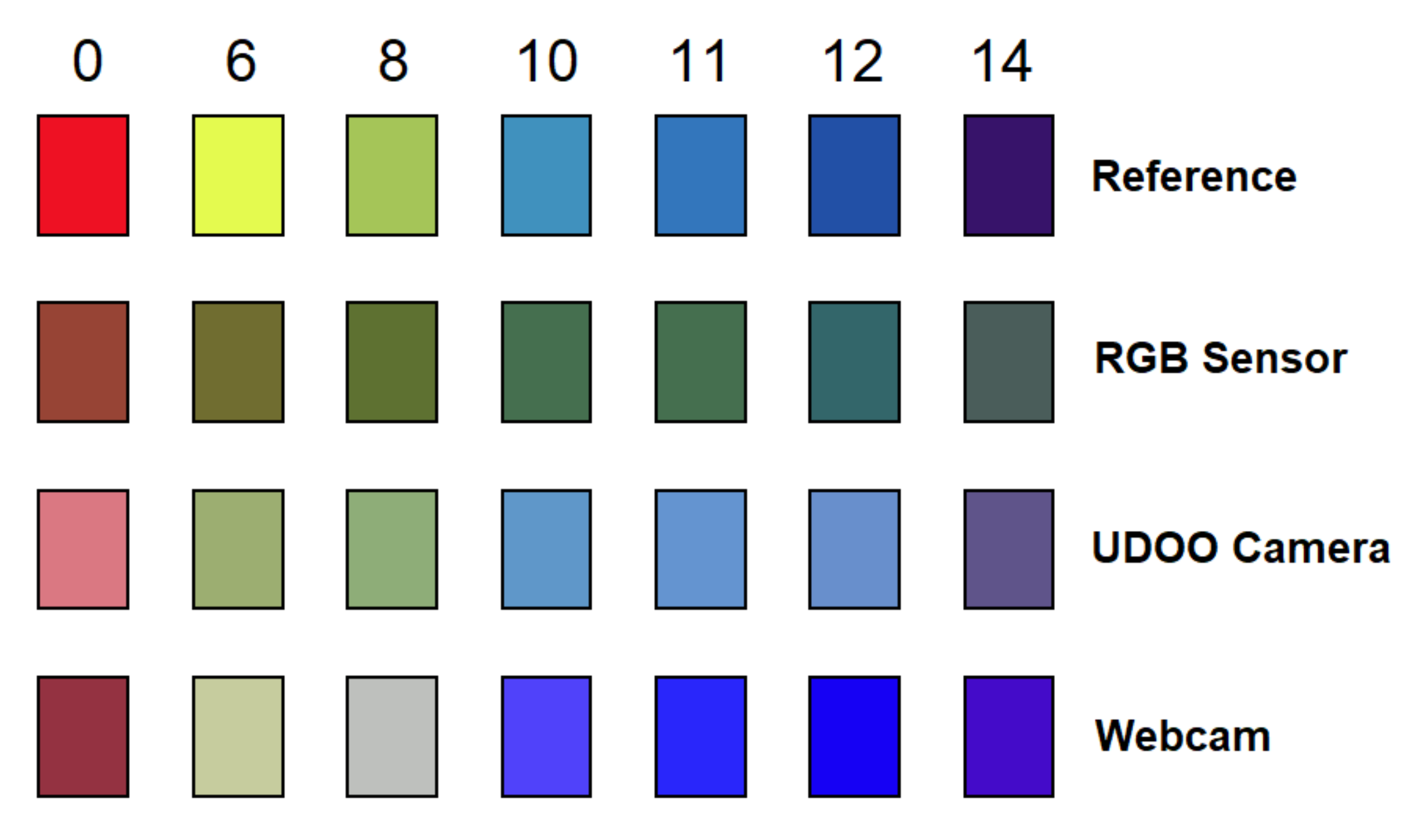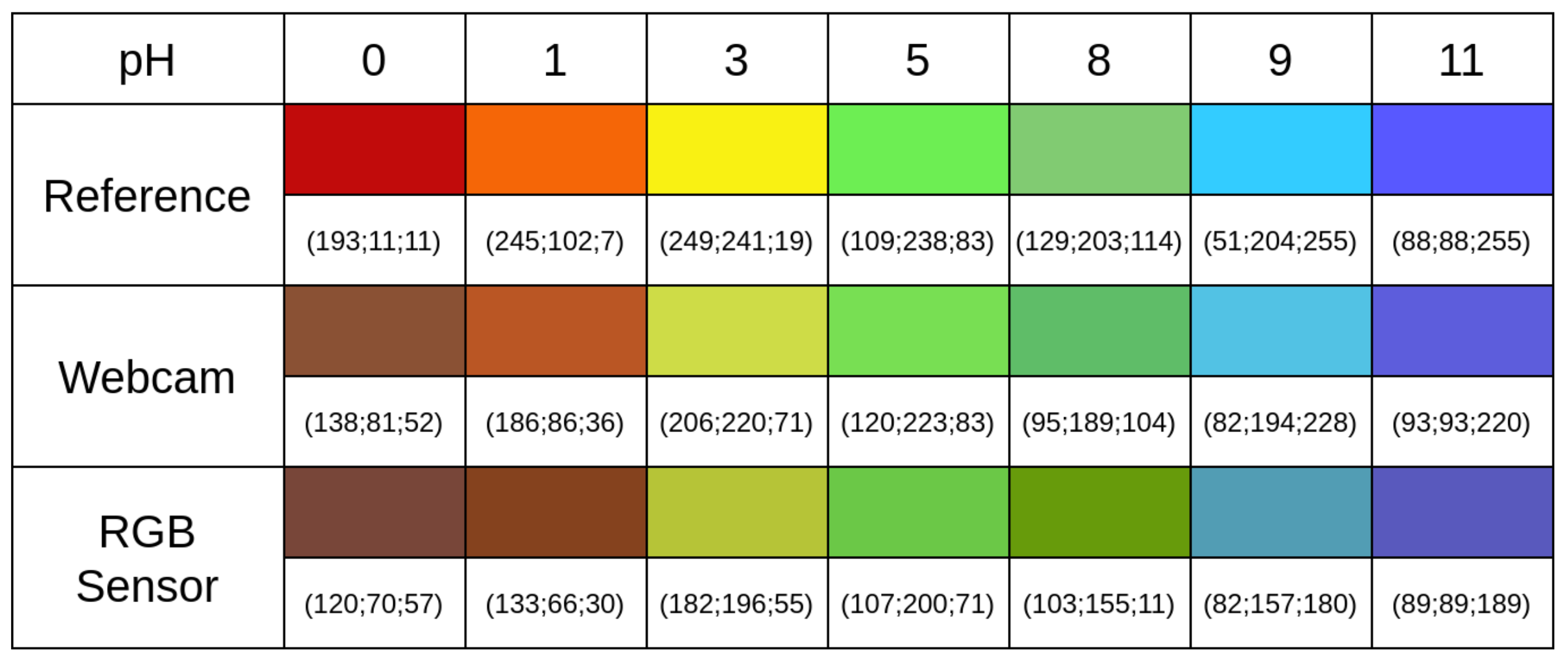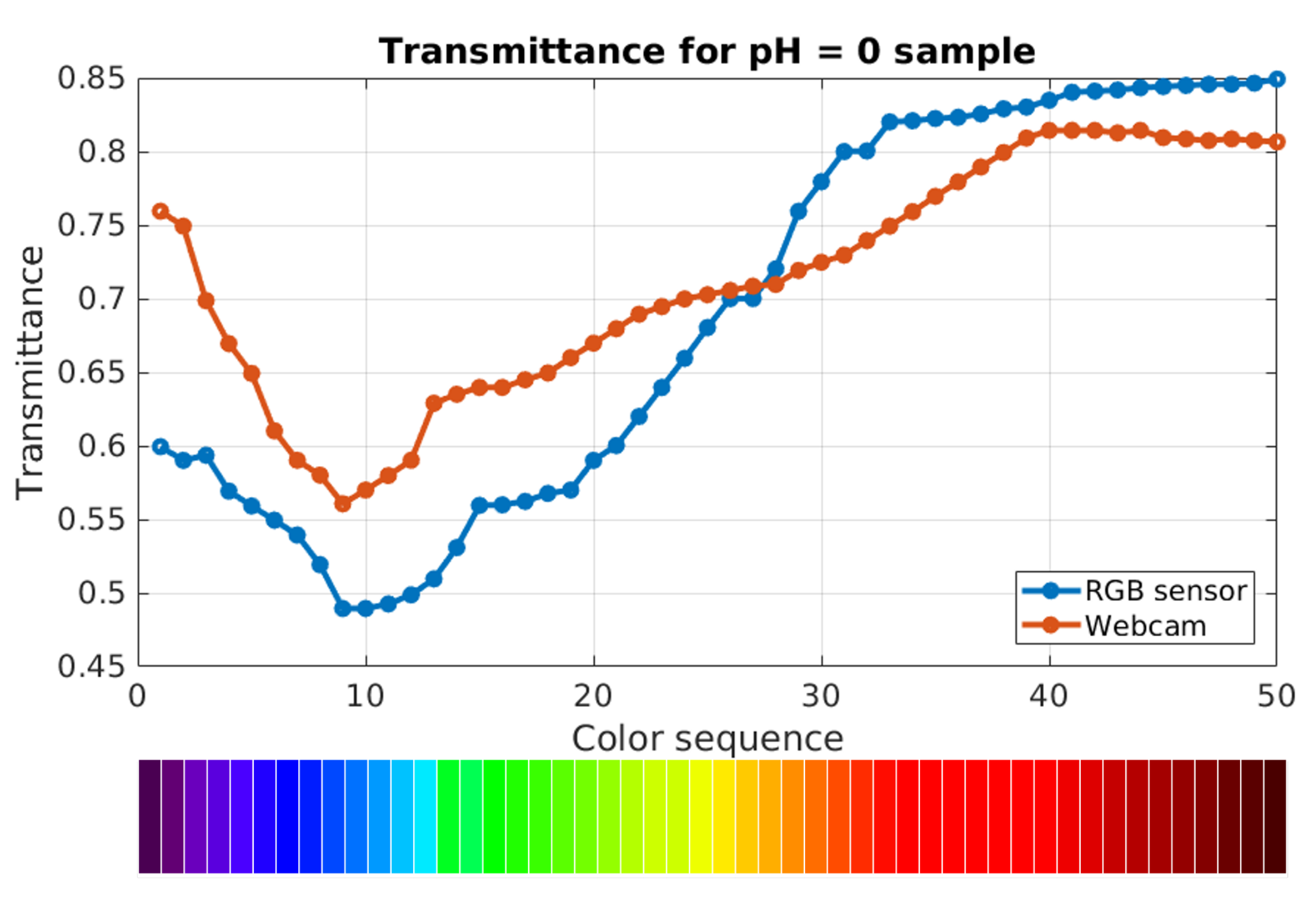Compact System for Colorimetric Sensor Arrays Characterization Based on Computer Screen Photo-Assisted Technology
Abstract
1. Introduction
- Use any type of screen available as a light source: desktops, laptops, displays or even cell phone screens;
- Use low-cost and easily accessible devices such as webcams for the detection process;
- Obtain a highly customizable device: the kind of application is in fact determined by the sensors typologies that are used (medical diagnostic, environmental monitoring, etc.) while the platform used is always the same;
- Avoid to install any particular software: often an internet connection is enough to send the video file and obtain measured data;
- Evaluate any colorimetric phenomenon (absorption, reflection, emission, etc.);
- Use any commercially available material as an indicator material.
2. Materials and Methods
3. Results
3.1. Measurement Setup Optimization
3.2. Tests on the Detectors
3.3. Detectors Comparison
3.4. Measurements
4. Conclusions
Author Contributions
Funding
Acknowledgments
Conflicts of Interest
Abbreviations
| B | Blue |
| CSI | Camera Serial Interface |
| CSPT | Computer Screen Photo-assisted Technique |
| G | Green |
| GOD | Glucose Oxidase enzyme |
| I2C | Inter-Integrated Circuit |
| LCD | Liquid Crystal Display |
| LED | Light Emission Diode |
| LVDS | Low-Voltage Differential Signaling |
| PC | Personal Computer |
| pH | potential of Hydrogen |
| R | Red |
| ROI | Region of Interest |
| SLPT | Scanning Light Pulse Technique |
| SPI | Serial Peripheral Interface |
| USB | Universal Serial Bus |
References
- Gruber, P.; Marques, M.P.; Szita, N.; Mayr, T. Integration and application of optical chemical sensors in microbioreactors. Lab Chip 2017, 17, 2693–2712. [Google Scholar] [CrossRef]
- Muthukumar, P.; John, S.A. Highly sensitive detection of HCl gas using a thin film of meso-tetra (4-pyridyl) porphyrin coated glass slide by optochemical method. Sens. Actuators B Chem. 2011, 159, 238–244. [Google Scholar] [CrossRef]
- Lin, F.W.; Xu, X.L.; Wu, J.; Wan, L.S.; Xu, Z.K. Cobalt-porphyrin/dansyl piperazine complex coated filter paper for “turn on” fluorescence sensing of ammonia gas. RSC Adv. 2015, 5, 99361–99363. [Google Scholar] [CrossRef]
- Kladsomboon, S.; Kerdcharoen, T. A method for the detection of alcohol vapours based on optical sensing of magnesium 5, 10, 15, 20-tetraphenyl porphyrin thin film by an optical spectrometer and principal component analysis. Anal. Chim. Acta 2012, 757, 75–82. [Google Scholar] [CrossRef]
- Bozkurt, S.S.; Merdivan, E.; Benibol, Y. A fluorescent chemical sensor for ethanol determination in alcoholic beverages. Microchim. Acta 2010, 168, 141–145. [Google Scholar] [CrossRef]
- Prosposito, P.; Burratti, L.; Venditti, I. Silver nanoparticles as colorimetric sensors for water pollutants. Chemosensors 2020, 8, 26. [Google Scholar] [CrossRef]
- Weston, M.; Kuchel, R.P.; Ciftci, M.; Boyer, C.; Chandrawati, R. A polydiacetylene-based colorimetric sensor as an active use-by date indicator for milk. J. Colloid Interface Sci. 2020, 572, 31–38. [Google Scholar] [CrossRef]
- Li, Z.; Suslick, K.S. Colorimetric sensor array for monitoring CO and ethylene. Anal. Chem. 2018, 91, 797–802. [Google Scholar] [CrossRef]
- Promphet, N.; Rattanawaleedirojn, P.; Siralertmukul, K.; Soatthiyanon, N.; Potiyaraj, P.; Thanawattano, C.; Hinestroza, J.P.; Rodthongkum, N. Non-invasive textile based colorimetric sensor for the simultaneous detection of sweat pH and lactate. Talanta 2019, 192, 424–430. [Google Scholar] [CrossRef]
- Zhu, X.; Chen, W.; Wu, K.; Li, H.; Fu, M.; Liu, Q.; Zhang, X. A colorimetric sensor of H2O2 based on Co3O4–montmorillonite nanocomposites with peroxidase activity. New J. Chem. 2018, 42, 1501–1509. [Google Scholar] [CrossRef]
- Gavrilenko, N.A.; Saranchina, N.V.; Gavrilenko, M.A. A colorimetric sensor based on a polymethacrylate matrix with immobilized 1-(2-pyridylazo)-2-naphthol for the determination of cobalt. J. Anal. Chem. 2015, 70, 1475–1479. [Google Scholar] [CrossRef]
- Gavrilenko, N.A.; Saranchina, N.V.; Gavrilenko, M.A. Colorimetric sensor based on silver nanoparticle–Embedded polymethacrylate matrix. In Advanced Materials Research; Trans Tech Publ. Switzerland: Bäch, Switzerland, 2014; Volume 1040, pp. 923–927. [Google Scholar]
- Soga, T.; Jimbo, Y.; Suzuki, K.; Citterio, D. Inkjet-printed paper-based colorimetric sensor array for the discrimination of volatile primary amines. Anal. Chem. 2013, 85, 8973–8978. [Google Scholar] [CrossRef] [PubMed]
- Sahu, M.; Shrivas, K.; Kant, T.; Patel, S.; Devi, R.; Dahariya, N.S.; Pervez, S.; Deb, M.K.; Rai, M.K.; Rai, J.; et al. Inkjet-printed paper-based colorimetric sensor coupled with smartphone for determination of mercury (Hg2+). J. Hazard. Mater. 2021, 414, 125440. [Google Scholar]
- Donato, N.; Aloisio, D.; Leonardi, S.G.; Neri, G. Ink-jet printed colorimetric sensor for the determination of Fe (II). IEEE Sens. J. 2014, 15, 3196–3200. [Google Scholar] [CrossRef]
- Chen, Y.; Fu, G.; Zilberman, Y.; Ruan, W.; Ameri, S.K.; Zhang, Y.S.; Miller, E.; Sonkusale, S.R. Low cost smart phone diagnostics for food using paper-based colorimetric sensor arrays. Food Control 2017, 82, 227–232. [Google Scholar] [CrossRef]
- Jalal, U.M.; Jin, G.J.; Shim, J.S. Paper–plastic hybrid microfluidic device for smartphone-based colorimetric analysis of urine. Anal. Chem. 2017, 89, 13160–13166. [Google Scholar] [CrossRef]
- Sharifi, H.; Tashkhourian, J.; Hemmateenejad, B. A 3D origami paper-based analytical device combined with PVC membrane for colorimetric assay of heavy metal ions: Application to determination of Cu (II) in water samples. Anal. Chim. Acta 2020, 1126, 114–123. [Google Scholar] [CrossRef]
- Dong, R.E.; Kang, P.; Xu, X.L.; Cai, L.X.; Guo, Z. Cation-exchange strategy for a colorimetric paper sensor: Belt-like ZnSe nanoframes toward visual determination of heavy metal ions. Sens. Actuators B Chem. 2020, 312, 128013. [Google Scholar] [CrossRef]
- Zhao, L.; Zhao, L.; Miao, Y.; Liu, C.; Zhang, C. A colorimetric sensor for the highly selective detection of sulfide and 1, 4-dithiothreitol based on the in situ formation of silver nanoparticles using dopamine. Sensors 2017, 17, 626. [Google Scholar] [CrossRef]
- Terra, I.A.; Mercante, L.A.; Andre, R.S.; Correa, D.S. Fluorescent and colorimetric electrospun nanofibers for heavy-metal sensing. Biosensors 2017, 7, 61. [Google Scholar] [CrossRef] [PubMed]
- Wei, W.; Huang, J.; Gao, W.; Lu, X.; Shi, X. Carbon Dots Fluorescence-Based Colorimetric Sensor for Sensitive Detection of Aluminum Ions with a Smartphone. Chemosensors 2021, 9, 25. [Google Scholar] [CrossRef]
- Obrovski, B.; Bajić, J.; Mihajlović, I.; Miloradov, M.V.; Batinić, B.; Živanov, M. Colorimetric fiber optic probe for measurement of chemical parameters in surface water. Sens. Actuators B Chem. 2016, 228, 168–173. [Google Scholar] [CrossRef]
- Schmitt, K.; Rist, J.; Peter, C.; Wöllenstein, J. Low-cost fiber-optic waveguide sensor for the colorimetric detection of ammonia. Microsyst. Technol. 2012, 18, 843–848. [Google Scholar] [CrossRef]
- Santonico, M.; Scozzari, A.; Brozzo, G.; Marini, L.; D’Amico, A.; Filippini, D.; Lundström, I.; Di Natale, C. Detection of natural Cr (VI) with computer screen photo-assisted technology. Procedia Chem. 2009, 1, 317–320. [Google Scholar] [CrossRef][Green Version]
- Polese, D.; Magna, G.; Dini, F.; Martinelli, E.; Paolesse, R.; D’Amico, A.; Filippini, D.; Lundström, I.; Di Natale, C. Facile sensors replacement in optical gas sensors array. Procedia Eng. 2011, 25, 35–38. [Google Scholar] [CrossRef][Green Version]
- Askim, J.R.; Suslick, K.S. Hand-held reader for colorimetric sensor arrays. Anal. Chem. 2015, 87, 7810–7816. [Google Scholar] [CrossRef]
- Debus, B.; Kirsanov, D.; Yaroshenko, I.; Sidorova, A.; Piven, A.; Legin, A. Two low-cost digital camera-based platforms for quantitative creatinine analysis in urine. Anal. Chim. Acta 2015, 895, 71–79. [Google Scholar] [CrossRef]
- Giri, B. 11—Simultaneous Determination of Protein and Glucose in Urine Sample Using a Paper-Based Bioanalytical Device. In Laboratory Methods in Microfluidics; Giri, B., Ed.; Elsevier: Amsterdam, The Netherlands, 2017; pp. 69–75. [Google Scholar] [CrossRef]
- Mao, K.; Yang, Z.; Li, J.; Zhou, X.; Li, X.; Hu, J. A novel colorimetric biosensor based on non-aggregated Au@ Ag core–shell nanoparticles for methamphetamine and cocaine detection. Talanta 2017, 175, 338–346. [Google Scholar] [CrossRef]
- Paolesse, R.; Alimelli, A.; D’Amico, A.; Venanzi, M.; Battistini, G.; Montalti, M.; Filippini, D.; Lundström, I.; Di Natale, C. Insights on the chemistry of a, c-biladienes from a CSPT investigation. New J. Chem. 2008, 32, 1162–1166. [Google Scholar] [CrossRef]
- Filippini, D.; Comina, G.; Lundström, I. Computer screen photo-assisted reflectance fingerprinting. Sens. Actuators B Chem. 2005, 107, 580–586. [Google Scholar] [CrossRef]
- Di Natale, C.; Filippini, D.; Pennazza, G.; Santonico, M.; Paolesse, R.; Bellincontro, A.; Mencarelli, F.; D’Amico, A.; Lundström, I. Sorting of apricots with computer screen photoassisted spectral reflectance analysis and electronic nose. Sens. Actuators B Chem. 2006, 119, 70–77. [Google Scholar] [CrossRef]
- Manzano, J.; Filippini, D.; Lundström, I. Computer screen illumination for the characterization of colorimetric assays. Sens. Actuators B Chem. 2003, 96, 173–179. [Google Scholar] [CrossRef]
- Polese, D.; Martinelli, E.; Magna, G.; Dini, F.; Catini, A.; Paolesse, R.; Lundstrom, I.; Di Natale, C. Sharing data processing among replicated optical sensor arrays. Sens. Actuators B Chem. 2013, 179, 252–258. [Google Scholar] [CrossRef]
- Yoo, Y.; Yoo, W.S. Turning Image Sensors into Position and Time Sensitive Quantitative Colorimetric Data Sources with the Aid of Novel Image Processing/Analysis Software. Sensors 2020, 20, 6418. [Google Scholar] [CrossRef]
- Dini, F.; Filippini, D.; Paolesse, R.; Lundström, I.; Di Natale, C. Computer screen assisted digital photography. Sens. Actuators B Chem. 2013, 179, 46–53. [Google Scholar] [CrossRef]
- Wyszecki, G.; Stiles, W.S. Color science: Concepts and methods, quantitative data and formulas. Phys. Bull. 1982, 18, 353. [Google Scholar] [CrossRef]
- Paolesse, R.; Nardis, S.; Monti, D.; Stefanelli, M.; Di Natale, C. Porphyrinoids for chemical sensor applications. Chem. Rev. 2017, 117, 2517–2583. [Google Scholar] [CrossRef]
- Filippini, D.; Lundström, I. Chemical imaging by a computer screen aided scanning light pulse technique. Appl. Phys. Lett. 2002, 81, 3891–3893. [Google Scholar] [CrossRef]
- Paolesse, R.; Monti, D.; Dini, F.; Di Natale, C. Fluorescence based sensor arrays. Lumin. Appl. Sens. Sci. 2010, 139–174. [Google Scholar] [CrossRef]
- Lombardo, L.; Parvis, M.; Angelini, E.; Grassini, S. An Optical Sampling System for Distributed Atmospheric Particulate Matter. IEEE Trans. Instrum. Meas. 2019, 68, 2396–2403. [Google Scholar] [CrossRef]
- Iannucci, L.; Lombardo, L.; Parvis, M.; Cristiani, P.; Basséguy, R.; Angelini, E.; Grassini, S. An imaging system for microbial corrosion analysis. In Proceedings of the 2019 IEEE International Instrumentation and Measurement Technology Conference (I2MTC), Auckland, New Zealand, 20–23 May 2019; pp. 1–6. [Google Scholar] [CrossRef]
- UDOO Single Board COMPUTER: X86 and ARM POWERFUL Arduino Mini PC. 2020. Available online: https://www.udoo.org/ (accessed on 14 August 2021).
- Borrello, G.; Salvato, E.; Gugliandolo, G.; Marinkovic, Z.; Donato, N. UDOO-Based Environmental Monitoring System. In Applications in Electronics Pervading Industry, Environment and Society; De Gloria, A., Ed.; Springer International Publishing: Cham, Switzerland, 2017; pp. 175–180. [Google Scholar]
- Gugliandolo, G.; Campobello, G.; Marinkovic, Z.; Crupi, G.; Quartarone, A.; Neri, G.; Donato, N. Development of a multi-transduction system for breath analysis in neurodegenerative diseases. In Proceedings of the 2021 IEEE International Symposium on Medical Measurements and Applications (MeMeA), Lausanne, Switzerland, 23–25 June 2021; pp. 1–6. [Google Scholar] [CrossRef]
- Campobello, G.; Segreto, A.; Donato, N. A new frequency estimation algorithm for IIoT applications and low-cost instrumentation. In Proceedings of the 2020 IEEE International Instrumentation and Measurement Technology Conference (I2MTC), Dubrovnik, Croatia, 25–28 May 2020; pp. 1–5. [Google Scholar] [CrossRef]
- Jackson, R.; MacDonald, L.; Freeman, K. Computer Generated Color: A Practical Guide to Presentation and Display; John Wiley & Sons, Inc.: Hoboken, NJ, USA, 1994. [Google Scholar]










| Sensor | Ref-R | Ref-G | Ref-B | Mean | StDev (%) |
|---|---|---|---|---|---|
| RGB Sensor | 0.951 | 0.732 | 0.813 | 0.832 | 13.317 |
| UDOO Camera | 0.943 | 0.910 | 0.922 | 0.925 | 1.800 |
| Webcam | 0.877 | 0.885 | 0.937 | 0.900 | 3.642 |
| Values | Reference | RGB Sensor | UDOO | Webcam |
|---|---|---|---|---|
| Reference | 1 | |||
| RGB Sensor | 0.863 | 1 | ||
| UDOO Camera | 0.724 | 0.718 | 1 | |
| Webcam | 0.917 | 0.956 | 0.772 | 1 |
Publisher’s Note: MDPI stays neutral with regard to jurisdictional claims in published maps and institutional affiliations. |
© 2021 by the authors. Licensee MDPI, Basel, Switzerland. This article is an open access article distributed under the terms and conditions of the Creative Commons Attribution (CC BY) license (https://creativecommons.org/licenses/by/4.0/).
Share and Cite
Gugliandolo, G.; Pilato, G.; Donato, N. Compact System for Colorimetric Sensor Arrays Characterization Based on Computer Screen Photo-Assisted Technology. Electronics 2021, 10, 2587. https://doi.org/10.3390/electronics10212587
Gugliandolo G, Pilato G, Donato N. Compact System for Colorimetric Sensor Arrays Characterization Based on Computer Screen Photo-Assisted Technology. Electronics. 2021; 10(21):2587. https://doi.org/10.3390/electronics10212587
Chicago/Turabian StyleGugliandolo, Giovanni, Giovanni Pilato, and Nicola Donato. 2021. "Compact System for Colorimetric Sensor Arrays Characterization Based on Computer Screen Photo-Assisted Technology" Electronics 10, no. 21: 2587. https://doi.org/10.3390/electronics10212587
APA StyleGugliandolo, G., Pilato, G., & Donato, N. (2021). Compact System for Colorimetric Sensor Arrays Characterization Based on Computer Screen Photo-Assisted Technology. Electronics, 10(21), 2587. https://doi.org/10.3390/electronics10212587








